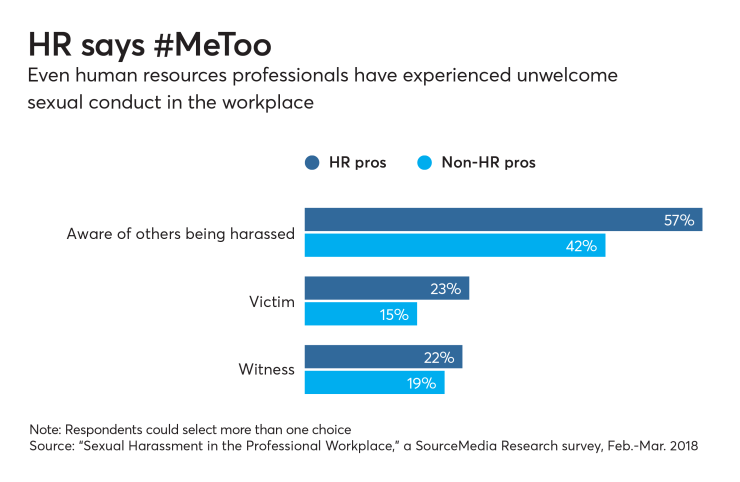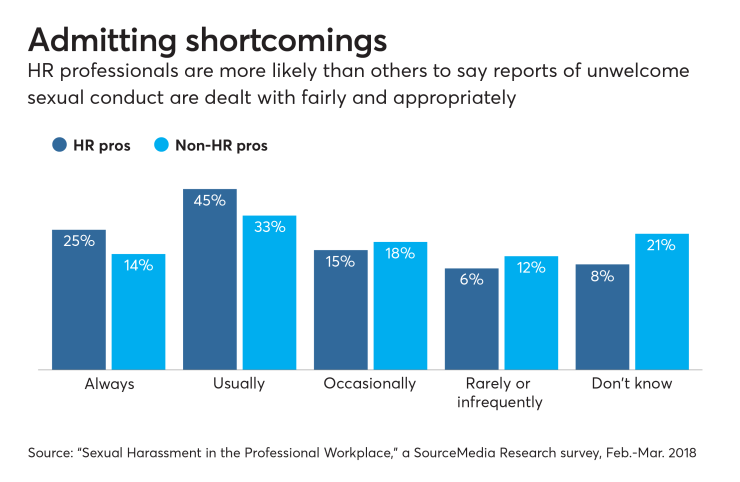During Amy Newman’s nearly decade-long career in human resources, she witnessed no shortage of questionable sexual behavior in the workplace.
“People participated in affairs that I don’t think they would have if there wasn’t a power dynamic. There is no such thing as consensual sex when there is a power relationship,” said Newman, now a senior lecturer of management communication at Cornell University and the author of “Building Leadership Character.” “Management knew about it and didn’t do anything.”
At CTIS, a Tampa, Fla., cable television installation and service company with 225 employees, HR manager Cecilia Brandon said inappropriate workplace behavior, including flirting between staffers, is common. But what often is considered harmless has at times turned into larger issues that resulted in employee complaints.
Also in this series:
These cases demonstrate a difficult task for HR professionals: how to handle not only clear cases of workplace sexual harassment, but also other inappropriate sexual behavior or misconduct that crosses the ethical line — behavior that is often ignored or even initiated by senior management.
While there may be widespread inappropriate behavior in the workplace, much of it does not rise to the level of harassment in a legal sense. Under the legal definition, the misconduct must explicitly or implicitly violate a term or condition of an individual’s employment or a factor used as the basis for employment decisions; unreasonably interfere with work performance; or create an intimidating, hostile or offensive working environment, said Dave Ulrich, director of the Human Resource Executive Program at the University of Michigan.
That legal threshold likely is the reason for a large discrepancy in a new SourceMedia survey of 409 HR and benefits professionals: Although half of HR professionals (52%) said they believe the level of workplace sexual harassment in their industry is low overall, the vast majority (70%) admitted they either are aware that others were the subjects of unwelcome sexual conduct in the workplace or that they’ve witnessed such conduct themselves. The most common of those behaviors were inappropriate jokes, personal questions or innuendo (62%), suggestive text messages or emails (27%) and persistent unwelcome advances (24%).

Overall, the survey, titled “Sexual Harassment in the Professional Workplace,” had more than 3,000 respondents across a range of white-collar industries, including banking, wealth management, health care and capital markets.
The survey found that the problem of sexual misconduct is so widespread that even HR professionals are not immune to it. More than 20% of HR and benefits professionals polled said they, too, have been a subject of unwelcome sexual conduct in the workplace. That’s higher than the average found across other professions; 16% of the survey respondents overall said the same.
HR professionals cited two factors as being the most important in curbing sexual harassment: changing workplace culture (75%) and commitment from upper management (69%). These are so vital that HR professionals were significantly more likely to say those two changes are needed than were survey respondents in other professions.
“More training is more of the same,” said Johnny Taylor, president and chief executive of the Society of Human Resource Management. “Training, investigations — we’ve checked those boxes. We’ve got to get HR focused on culture.”
Many HR professionals, aware that poor workplace culture is too often enabled from the top down, are readying for a cultural transformation of sorts — one where they begin to truly advocate for workers and start to act as the employer’s conscience. It’s a role, they say, that has largely been ignored until now.
“HR has to put in place mechanisms so that we can really be fully, fully aware of what’s happening within the culture of the organization and determine how we are going to define that culture,” Taylor said. “What is our cultural tolerance for these behaviors? Forget the law — because the law says [some] behaviors are legally acceptable — but for the behaviors that don’t rise to those levels, what is acceptable? Someone has to own culture and it should be HR.”
A historical problem
The HR professionals who participated in the SourceMedia survey come from many different industries, from banking to health care. The primary reasons they cited for the problem of workplace sexual misconduct are: senior management being mostly male, “good old boy” networks and bad company culture. Some also point to a lack of policy enforcement by management — or even processes that protect upper management and high performers and help the company avoid liability.
“As much as we hate to admit it, there is a significant amount of office politics in most companies,” Brandon said. “There are instances where HR professionals are encouraged or directed as to what the outcome of the investigation should be that would be most advantageous to the company and its key players.”
Though she doesn’t have such interference from her current employer — “ownership is extremely supportive of my position and recommendations,” she said — that hasn’t always been her experience. “In a company I worked for in previous years, there were a few instances where our highest-producing sales representatives had repeated violations. Upper-level management did not handle the matter properly in many ways and made sure my department was aware of the consequences of the loss,” she said, noting it impacted her decisions on handling the matter.

Upper management influence — and poor behavior — is likely why just 25% of HR professionals in SourceMedia’s survey said they think reports of unwelcome sexual conducts are “always” dealt with fairly and appropriately, Brandon said.
Ulrich agreed, saying that the #MeToo movement is beginning to move the needle when it comes to making lasting changes to company culture.
“The harassment and hostile work environment are generally not created by HR, but by line managers, senior leaders in positions of influence and/or a cultural heritage,” he said. “HR has a difficult job to confront these bad situations and create a healthy work environment and to root out bad behaviors. Transparency is a good thing to enable this action.”
SourceMedia data supports this too. Of HR professionals polled, 40% said the #MeToo movement will have some impact on their industry this year, 24% said it will have a little impact and 10% said it will have a high impact. Just 13% said it would have no impact.
But #MeToo is just the beginning, according to many HR managers. The movement has brought awareness to the problem; now it’s HR’s turn to start making permanent culture changes. That involves better training and investigation, but more important it also means standing up to senior management and leading them to a better way of tackling this issue.
“It may sound sophomoric,” Taylor said, but at some companies involved in harassment cases, “people say ‘everyone knew,’ but sometimes it doesn’t get to senior management or HR and it doesn’t get addressed. CEOs and management have to empower HR to be great, and empower them to be ethical.”
Responses to the SourceMedia survey indicate that incidents of inappropriate workplace behavior are lower in companies where a strong culture — one that is led and exemplified by top executives — is in effect. Many respondents — including Colleen O’Leary, director of human resources at Community, Counseling and Correctional Services, a nonprofit organization with roughly 600 employees in three states — said in written comments that a supportive and respectful culture, led by management, is a primary reason for the low incidences of harassment at their companies.
“We have a strong moral and ethical backbone, and if you want to stay with the company, you have to believe in it,” O’Leary said. That’s echoed by the firm’s CEO — people look up to him as “a father figure” and don’t want to let him down, she said.

“Everybody that gets hired here has that same feeling. Workplace culture is so important. We would not be where we are without our CEO and the tone that he sets,” she said, noting that the CEO talks to each new employee at orientation about the importance of respect and integrity.
It’s vital for HR professionals to uphold a company’s values as well, O’Leary said.
Promoting workplace culture “is the most important thing I do,” she said. “You embody it, you model it, you live it and show it and breathe it. If you don’t buy into it, you shouldn’t be in the business.”
(SourceMedia, which publishes Employee Benefit News, conducted its online survey of more than 3,000 professionals across multiple industries in the first quarter of 2018. The study, “Sexual Harassment in the Professional Workplace,” is a joint project of SourceMedia’s editorial and research departments.)





